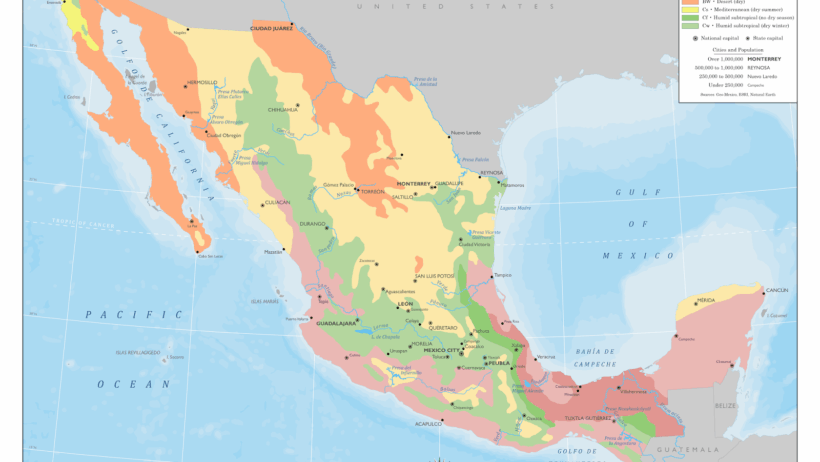Mexico, a vibrant tapestry of cultures, boasts an equally diverse range of climates. From the arid deserts of the north to the tropical shores of the south, the climatic conditions across the nation play a crucial role in shaping its landscapes, biodiversity, and human activities. Understanding the various climates of Mexico not only reveals the country’s natural beauty but also opens a window to its ecological complexities.
To appreciate the enchanting climates of Mexico, it is essential to delve into the fundamental classification: the Köppen climate classification system. This system underscores the interplay between temperature, precipitation, and vegetation. The result is a rich mosaic of climatic zones that not only vary by region but also influence the socio-economic fabric of the country.
Exploring the Arid and Semi-Arid Regions
The arid and semi-arid climates dominate Mexico’s northern expanse, characterized by low annual rainfall and high evaporation rates. These regions, notably found in states like Chihuahua and Sonora, are punctuated by vast deserts and shimmering oases, creating an enthralling contrast. The Chihuahua Desert is a quintessential example, draped in golden sands and sporadic plant life that has remarkably adapted to the harsh environment.
The aesthetic appeal of these landscapes lies in their stark beauty. The sunsets here are nothing short of spectacular, painting the skies with hues of orange, pink, and purple. Cacti species, like the iconic saguaro, stand tall against the backdrop of expansive horizons, inviting photographers and adventurers alike to capture the ethereal charm of the desert. Despite the aridity, life thrives—endemic species such as the elusive bobcat or the hardy prickly pear have evolved unique survival strategies, showcasing nature’s remarkable resilience.
The Vibrance of Tropical Climates
Traveling southward, a dramatic transformation occurs as the landscape transitions into lush, tropical environments. The coastal regions, especially along the Pacific and Caribbean seas, revel in a humid tropical climate—characterized by warm temperatures and abundant rainfall. States such as Veracruz and Quintana Roo exemplify these conditions, teeming with exotic flora and fauna.
The aesthetic allure of tropical Mexico is striking. Imagine vibrant jungles where sunlight filters through a canopy of leaves, illuminating a plethora of colors. The biodiversity is staggering; from the playful howler monkeys swinging through the treetops to the iridescent butterflies dancing from flower to flower, every moment feels like a glimpse into an untouched paradise. This climate not only supports various ecosystems but also offers local inhabitants a wealth of resources, making agriculture flourish by cultivating crops such as cacao, coffee, and vanilla—each possessing tantalizing aromas that are synonymous with the region.
The Enigmatic Highland Climates
Transitioning further into Mexico, one encounters the highland climates, characterized by cooler temperatures and distinct wet and dry seasons. These climates can be witnessed in states like Puebla and Oaxaca, where the altitudes influence temperature variations dramatically. The highlands are predominantly known for their temperate and subpolar zones, providing a refreshing escape from the sweltering heat of lower elevations.
The villages nestled in these highlands often serve as cultural keystones, preserving indigenous traditions that date back centuries. The backdrop of rolling hills and majestic mountains is awe-inspiring, especially when dusted with the occasional mist. This region is also famous for its diversity of agriculture; crops such as maize, beans, and squash thrive here, a testament to the rich heritage of Mexico’s agricultural practices. Envision the harvest festivals, where vibrant colors of traditional attire juxtapose against the backdrop of green fields, an enduring celebration of the land’s bounty.
Understanding Humid and Semi-Humid Regions
A unique subcategory within Mexico’s climatic spectrum is the humid and semi-humid regions, often found in the eastern coastline and parts of the central plateaus. This climate is marked by a pronounced wet season, fostering a multitude of life both in the skies and underfoot. Forests here are dense and the biodiversity is unparalleled, attracting researchers and conservationists keen on understanding unique ecosystems.
The aesthetic of this environment is enchanting, where every inch is brimming with vibrancy. Radiant wildflowers carpets the soil, while birds of vivid plumage flit through the trees—a delightful orchestra of nature. The air is fragrant with the scent of wet earth, an inviting aroma that renews the spirit. Residents of these areas have deeply intertwined their lives with the land, employing sustainable practices that celebrate both the environment and their cultural identities.
The Climate’s Influence on Cultural Identity
In conclusion, the climatic diversity of Mexico is not merely a backdrop but serves as a fundamental influence on the nation’s cultural identity and ecological integrity. Each climate, be it the arid north, the tropics, or the cool highlands, creates unique lifestyles and sustainability practices that reflect the resilience of its people. The interplay between climate and culture invites curiosity and admiration, urging deeper exploration and understanding.
To truly appreciate Mexico is to recognize how its climates sculpt its landscapes and the lives of its inhabitants; every climate zone tells a distinct story, interwoven with the threads of nature and humanity. This intricate dance of environments and ecosystems is a testament to the country’s rich and enduring legacy, urging all to engage with its beauty and complexity.







